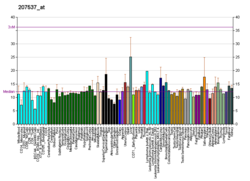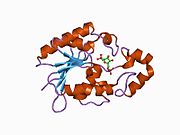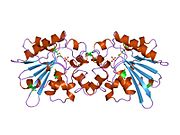| PFKFB1 |
|---|
 |
| Available structures |
|---|
| PDB | Ortholog search: PDBe RCSB |
|---|
|
|
| Identifiers |
|---|
| Aliases | PFKFB1, F6PK, HL2K, PFRX, 6-phosphofructo-2-kinase/fructose-2,6-biphosphatase 1 |
|---|
| External IDs | OMIM: 311790; MGI: 107816; HomoloGene: 105654; GeneCards: PFKFB1; OMA:PFKFB1 - orthologs |
|---|
| Gene location (Human) |
|---|
 | | Chr. | X chromosome (human)[1] |
|---|
| | Band | Xp11.21 | Start | 54,932,961 bp[1] |
|---|
| End | 54,998,534 bp[1] |
|---|
|
| Gene location (Mouse) |
|---|
 | | Chr. | X chromosome (mouse)[2] |
|---|
| | Band | X|X F3 | Start | 149,371,225 bp[2] |
|---|
| End | 149,426,874 bp[2] |
|---|
|
| RNA expression pattern |
|---|
| Bgee | | Human | Mouse (ortholog) |
|---|
| Top expressed in | - right lobe of liver
- gastrocnemius muscle
- vastus lateralis muscle
- biceps brachii
- triceps brachii muscle
- deltoid muscle
- adipose tissue
- subcutaneous adipose tissue
- abdominal fat
- tibialis anterior muscle
|
| | Top expressed in | - sternocleidomastoid muscle
- vastus lateralis muscle
- triceps brachii muscle
- masseter muscle
- tibialis anterior muscle
- temporal muscle
- digastric muscle
- gastrocnemius muscle
- right ventricle
- plantaris muscle
|
| | More reference expression data |
|
|---|
| BioGPS |  | | More reference expression data |
|
|---|
|
| Gene ontology |
|---|
| Molecular function | - transferase activity
- nucleotide binding
- fructose-6-phosphate binding
- kinase activity
- catalytic activity
- protein binding
- identical protein binding
- fructose-2,6-bisphosphate 2-phosphatase activity
- hydrolase activity
- ATP binding
- 6-phosphofructo-2-kinase activity
- kinase binding
| | Cellular component | - cytosol
- 6-phosphofructo-2-kinase/fructose-2,6-biphosphatase complex
| | Biological process | - gluconeogenesis
- response to glucagon
- glycolytic process
- phosphorylation
- fructose metabolic process
- response to glucocorticoid
- carbohydrate phosphorylation
- response to insulin
- positive regulation of glucokinase activity
- fructose 2,6-bisphosphate metabolic process
- animal organ regeneration
- response to starvation
- metabolism
- response to cAMP
- dephosphorylation
- negative regulation of glycolytic process
- positive regulation of glycolytic process
| | Sources:Amigo / QuickGO |
|
| Orthologs |
|---|
| Species | Human | Mouse |
|---|
| Entrez | | |
|---|
| Ensembl | | |
|---|
| UniProt | | |
|---|
| RefSeq (mRNA) | |
|---|
NM_001271804
NM_001271805
NM_002625 |
| NM_008824
NM_001374170
NM_001374171
NM_001374172
NM_001374173
|
|---|
NM_001374175 |
|
|---|
| RefSeq (protein) | |
|---|
NP_001258733
NP_001258734
NP_002616 |
| NP_032850
NP_001361099
NP_001361100
NP_001361101
NP_001361102
|
|---|
NP_001361104 |
|
|---|
| Location (UCSC) | Chr X: 54.93 – 55 Mb | Chr X: 149.37 – 149.43 Mb |
|---|
| PubMed search | [3] | [4] |
|---|
|
| Wikidata |
| View/Edit Human | View/Edit Mouse |
|

 1c7z: REGULATORY COMPLEX OF FRUCTOSE-2,6-BISPHOSPHATASE
1c7z: REGULATORY COMPLEX OF FRUCTOSE-2,6-BISPHOSPHATASE 1c80: REGULATORY COMPLEX OF FRUCTOSE-2,6-BISPHOSPHATASE
1c80: REGULATORY COMPLEX OF FRUCTOSE-2,6-BISPHOSPHATASE 1c81: MICHAELIS COMPLEX OF FRUCTOSE-2,6-BISPHOSPHATASE
1c81: MICHAELIS COMPLEX OF FRUCTOSE-2,6-BISPHOSPHATASE 1fbt: THE BISPHOSPHATASE DOMAIN OF THE BIFUNCTIONAL RAT LIVER 6-PHOSPHOFRUCTO-2-KINASE/FRUCTOSE-2,6-BISPHOSPHATASE
1fbt: THE BISPHOSPHATASE DOMAIN OF THE BIFUNCTIONAL RAT LIVER 6-PHOSPHOFRUCTO-2-KINASE/FRUCTOSE-2,6-BISPHOSPHATASE 1k6m: Crystal Structure of Human Liver 6-Phosphofructo-2-Kinase/Fructose-2,6-Bisphosphatase
1k6m: Crystal Structure of Human Liver 6-Phosphofructo-2-Kinase/Fructose-2,6-Bisphosphatase 1tip: THE BISPHOSPHATASE DOMAIN OF THE BIFUNCTIONAL RAT LIVER 6-PHOSPHOFRUCTO-2-KINASE/FRUCTOSE-2,6-BISPHOSPHATASE
1tip: THE BISPHOSPHATASE DOMAIN OF THE BIFUNCTIONAL RAT LIVER 6-PHOSPHOFRUCTO-2-KINASE/FRUCTOSE-2,6-BISPHOSPHATASE
























